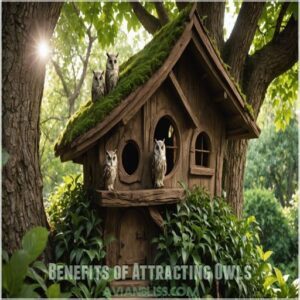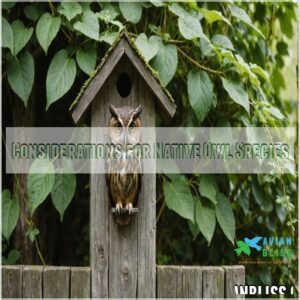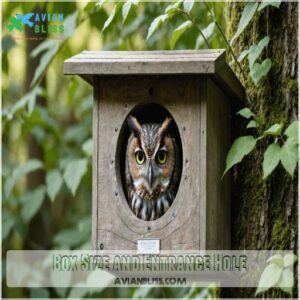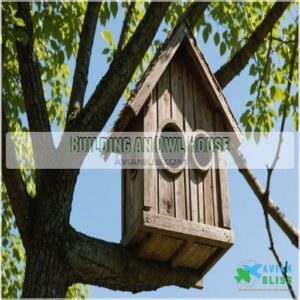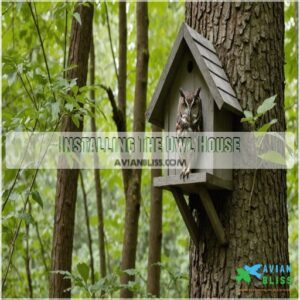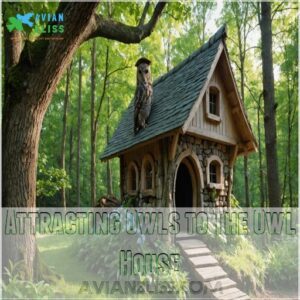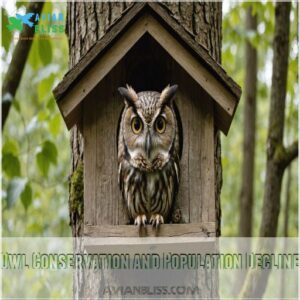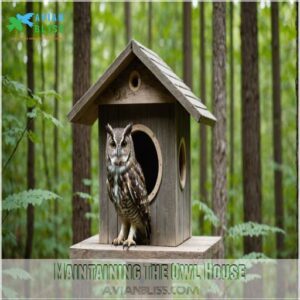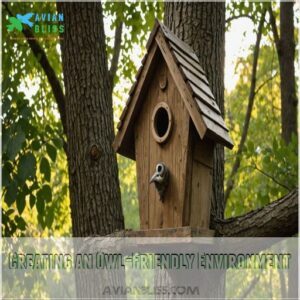This site is supported by our readers. We may earn a commission, at no cost to you, if you purchase through links.
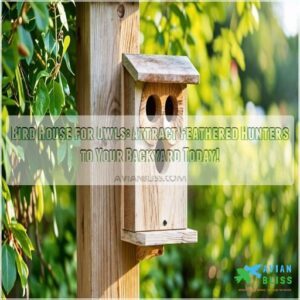
A bird house for owls is your ticket to hosting these fascinating nocturnal hunters.
You’ll need to build or buy a spacious box with a 6-8 inch entrance hole, placed 10-20 feet high in a quiet spot.
Remember, owls aren’t interior decorators – they prefer a bare-bones setup with some wood shavings for nesting.
Keep it away from bright lights and busy areas to make your feathered friends feel at home.
With a little patience, you might just hear the soft hoots of your new neighbors.
But there’s more to owl hospitality than just hanging a box – stick around to uncover the secrets of creating an owl paradise.
Table Of Contents
- Key Takeaways
- Benefits of Attracting Owls
- Choosing The Right Owl House
- Building an Owl House
- Installing The Owl House
- Attracting Owls to The Owl House
- Owl Nesting and Breeding Habits
- Common Owl Species and Their Needs
- Owl Conservation and Population Decline
- Maintaining The Owl House
- Creating an Owl-Friendly Environment
- Frequently Asked Questions (FAQs)
- What kind of bird house do owls like?
- How to attract an owl to an owl house?
- Where is the best place to put an owl house?
- Will owls use an owl house?
- How long does it take for owls to move in?
- Are owl houses safe for other backyard wildlife?
- Can multiple owl species use the same house?
- What predators might threaten owls in birdhouses?
- How often should owl houses be cleaned?
- Conclusion
Key Takeaways
- You’ll need a spacious owl house with a 6-8 inch entrance hole, placed 10-20 feet high in a quiet spot to attract these nocturnal hunters.
- Creating an owl-friendly environment includes leaving trees unpruned, reducing outdoor lighting, and providing food sources and water.
- Regular maintenance of your owl house, including monitoring for starlings, cleaning, and replacing nesting material, is crucial for keeping owls returning year after year.
- By attracting owls, you’re not only getting natural pest control but also supporting owl conservation efforts and creating birdwatching opportunities in your own backyard.
Benefits of Attracting Owls
You’ll be amazed at how owls can transform your backyard into a pest-free paradise.
These feathered hunters keep rodents and insects in check.
They also offer a thrilling birdwatching experience right outside your window.
Natural Pest Control
Ever dreamed of a pest-free garden without resorting to harsh chemicals?
Enter the owl, your feathered friend in the fight against rodents and insects.
These nocturnal hunters are nature’s answer to organic gardening, swooping in to snatch up pesky critters that threaten your veggies.
By installing owl boxes or screech owl houses, you’re inviting these silent predators to set up shop in your backyard.
It’s like having your own natural pest control team working the night shift!
Environmental Balance
While owls are nature’s pest control experts, they’re also key players in maintaining environmental balance.
By attracting these feathered hunters to your yard, you’re boosting biodiversity and supporting owl conservation efforts.
Their presence helps restore natural habitats and keeps rodent populations in check, creating a harmonious ecosystem.
It’s like inviting a skilled gardener to tend your backyard – they’ll keep things in order without you lifting a finger.
Plus, you’ll be giving these magnificent creatures a safe haven in our ever-changing world.
Birdwatching Opportunities
Night-owl enthusiasts, get ready for a hoot!
By attracting these feathered hunters to your backyard, you’re opening up a world of birdwatching opportunities.
You’ll witness owls in flight, silently gliding through the trees.
Listen for their distinctive calls and observe their fascinating nesting behavior up close.
From identifying different owl species to studying their unique habitat preferences, you’ll gain a front-row seat to nature’s nocturnal show.
It’s like having your own wildlife documentary right outside your window!
Choosing The Right Owl House
You’re ready to welcome owls to your backyard, but not all houses are hoot-worthy.
Picking the right owl house means considering your local owl species, getting the size and entrance hole just right, and using materials that’ll keep your feathered friends cozy and safe.
Considerations for Native Owl Species
Choosing the right owl house isn’t a hoot and holler.
You’ve got to think about your local feathered friends.
Barn owls, screech owls, and great horned owls all have different needs.
Think about their natural habitat and nest site preferences.
Are you in a wooded area or open field?
What’s their diet, and when’s breeding season?
Don’t forget about natural predators – your owl box should be a safe haven.
By matching your box to native species, you’ll be giving a leg up to these nocturnal hunters.
Box Size and Entrance Hole
For a cozy owl haven, size matters!
Your feathered friends need a roomy retreat.
Here’s the lowdown on crafting the perfect owl box:
- Spacious interior: 10-12 inches wide, 10-24 inches deep
- Entrance hole: 3-6 inches in diameter, depending on owl species
- Height placement: 10-15 feet off the ground
Remember, different owl species have unique preferences.
A well-sized box with the right hole will give your nocturnal neighbors a safe, comfy spot to call home.
Happy owl-hosting!
Materials and Construction
Ready to build your owl’s dream home? Let’s talk materials and construction for your DIY bird house.
Untreated cedar or pine are your go-to wood types for owl boxes.
They’re naturally resistant to decay and won’t harm your feathered friends.
To make sure your owl house is durable and weather-resistant, consider using a cedar birdhouse kit for a sturdy foundation.
Aim for sturdy 3/4-inch thick boards to keep the nest cozy and secure.
Remember, a sloped roof design with proper ventilation is key to keeping owls dry and comfortable in their new digs.
Building an Owl House
You’re about to become an owl landlord, and it’s easier than you think!
With just a few tools and some basic woodworking skills, you’ll be crafting a cozy home that’ll have owls hooting with delight in no time.
Tools and Materials Needed
If you’re interested in learning more about the majestic species you might attract to your yard, such as the Great Horned Owl or the Snowy Owl, the best place to start is by understanding their habitats and behaviors found in Michigan’s owl species and habitats. Time to gear up for your owl nesting box project! You’ll need:
- Wood: Untreated pine or cedar boards
- Hardware: Nails, screws, and exterior hinges
- Tools: Saw, drill, hammer, and tape measure
Don’t forget safety gear like gloves and goggles.
Building an owl house is like crafting a cozy cabin for feathered friends.
With these materials in hand, you’re all set to create a perfect perch for your backyard’s nocturnal hunters.
Cutting and Assembling The Box
Now that you’ve got your tools ready, let’s start building your owl’s dream home!
Measure and cut your wood pieces according to these owl box dimensions.
Here’s a handy guide to keep you on track:
| Piece | Dimensions (inches) | Quantity |
|---|---|---|
| Back | 16 x 12 | 1 |
| Sides | 16 x 10 | 2 |
| Bottom | 10 x 10 | 1 |
| Top | 14 x 12 | 1 |
Remember, measure twice, cut once!
You’ll be assembling these pieces like a puzzle, creating a cozy nesting box for your feathered friends.
Attaching The Front Panel and Hanging Hardware
You’ve assembled the box, and now it’s showtime! Secure the front panel with sturdy hinges, making sure it’s snug but can open for cleaning.
Next, let’s hang this owl palace. Choose robust hardware that’ll weather the elements and keep your feathered tenants safe. Measure twice, hang once – place it just right to prevent swaying.
Your owl nesting box is almost ready to welcome its first nocturnal residents!
Adding a Drainage Hole
Let’s not get your feathered friends’ feet wet!
After securing the front panel, it’s time to tackle moisture control.
Drill a small drainage hole in the bottom of your owl house, about 1/4 inch in diameter.
This clever addition prevents water buildup, keeping the nesting area dry and cozy.
Your owl tenants will thank you for this thoughtful touch, ensuring their new home stays comfy through rain or shine.
Installing The Owl House
You’re ready to welcome some feathered neighbors, but where should you hang that owl house?
Let’s explore the perfect spot for your new avian abode, balancing height, safety, and surroundings to create a cozy owl retreat that’ll have them hooting with approval.
Optimal Height and Security
With your owl house built, it’s time to give it a prime spot in your yard.
The right height and security are key for attracting these nocturnal neighbors.
Here’s what you need to know:
- Hang your owl nest box 12-18 feet high for the best safety
- Choose a sturdy tree with horizontal branches for perching
- Make sure the box faces away from prevailing winds
- Secure the box tightly to prevent swaying
- Add a predator guard below the box for extra protection
Placement Away From Entrances and Pathways
Now that you’ve got the height right, let’s talk about location.
Owls can be a bit protective of their nests, so it’s best to keep your owl house away from high-traffic areas.
Think of it as giving your feathered friends their own private sanctuary.
By placing the owl nesting box away from entrances and pathways, you’ll reduce human interaction and potential stress on the birds.
This setup guarantees both your safety and the owl’s peace of mind.
Considerations for Surrounding Trees and Branches
Once you’ve found the perfect spot away from bustling paths, it’s time to think about the feathered real estate market!
The surrounding trees and branches play a big role in your owl tenants’ comfort.
Here’s what to keep in mind:
- Branch height: Aim for 10-15 feet up
- Perch size: Look for sturdy, horizontal branches
- Prey access: Make sure there are clear flight paths for hunting
- Tree health: Choose robust, stable trees for long-term owl-friendly homes
Remember, you’re not just hanging a box, you’re creating a five-star owl habitat!
Attracting Owls to The Owl House
You’ve built the owl house, but now it’s time to roll out the welcome mat for your feathered friends.
With a few simple tricks, you’ll turn your backyard into an owl’s paradise,
complete with cozy digs and a five-star buffet.
Creating a Brush Pile for Prey
Your owl house is up, but let’s talk about the dinner menu!
Creating a brush pile is like setting up an all-you-can-eat buffet for owls.
Gather fallen branches, leaves, and yard debris to make a cozy hideout for small critters.
This mini-ecosystem will attract rodents, a favorite owl snack.
You’re not just building a pile; you’re crafting a thriving owl habitat right in your backyard!
Providing a Consistent Water Source
While a brush pile attracts prey, owls need more than just a snack bar.
They’re thirsty creatures too!
Set up a shallow bird bath or small pond near your owl house.
Keep the water clean and fresh, about 1-2 inches deep.
This owl-friendly oasis will have them hooting with joy.
Remember, a well-hydrated owl is a happy owl, ready to keep your garden pest-free!
Minimizing Outdoor Lighting
Now that you’ve got water sorted, let’s talk about creating an owl’s dream spot.
Owls are night owls (pun intended!), so bright lights are a no-go.
Dim those outdoor lights to create an owl-friendly yard. It’s a win-win: you’ll save energy and give nocturnal wildlife a chance to thrive.
Try using motion sensors or low-wattage bulbs near your owl house. This simple change can make a big difference in attracting these feathered hunters to your backyard.
Playing Owl Call Recordings
Once the stage is set with minimal lighting, it’s time to roll out the red carpet for your feathered guests.
Playing owl calls, particularly those like the distinctive "Who cooks for you? Who cooks for you-all?" of the Barred Owl Ohio Owl Sounds, can be your secret weapon in attracting these nocturnal hunters.
But hold your horses – it’s not as simple as blasting any old hoot.
Different
Owl Nesting and Breeding Habits
You’re about to step into the fascinating world of owl family life.
From courtship calls to understanding that owls choose a variety of nesting locations, including tree cavities and abandoned nests, to fuzzy owlets learning to fly, understanding owl nesting habits will help you create the perfect backyard haven for these nocturnal neighbors.
Territorial Behavior and Nesting Season
As spring rolls around, owls become fiercely territorial.
You’ll notice them getting more vocal and defensive about their turf.
They’re not just being grumpy neighbors; it’s all part of their nesting habits.
Owls are picky about their nest sites, often returning to the same spot year after year.
During breeding season, they’ll perform elaborate mating rituals to woo their partners.
It’s like a feathery soap opera right in your backyard!
Egg Laying and Incubation
The owl breeding season‘s in full swing!
Your feathered tenants are busy laying eggs, typically 4-5 cream-colored beauties.
Mom owl’s on incubation duty for about 26 days, while dad brings her snacks.
It’s like a cozy staycation, but with more hooting!
Keep your distance during this time – owls can get a bit protective.
Before you know it, tiny owl chicks will be peeking out of your owl house!
Parenting and Fledging
After hatching, owl parenting kicks into high gear.
You’ll witness a flurry of activity as both parents feed their hungry nestlings, often in nests they’ve taken over from other birds, a behavior known as nest takeover behavior.
These little fluffballs grow quickly, developing feathers and strength.
In about a month, they’ll take their first wobbly flights, practicing near the nest box.
It’s
Common Owl Species and Their Needs
You’ll find that understanding North Carolina owl sounds is crucial for identifying species, especially when attracting them to your backyard, as their calls can range from the Eastern Screech-Owl’s high-pitched whinnying to the Barn Owl’s bloodcurdling shriek. You’ll find Eastern Screech-Owls and Barn Owls in many backyards across North America.
Understanding these feathered neighbors will help you create the perfect owl-friendly habitat, turning your yard into a cozy home for these nocturnal hunters.
Eastern Screech-Owls
Ready to welcome a pint-sized predator to your yard?
Eastern Screech-Owls are your go-to nighttime neighbors!
These 9-inch tall hunters, with their 20-inch wingspans, come in gray or reddish-brown.
You’ll know they’re around when you hear their distinctive "whinny" call after dusk.
They’re not picky eaters, chowing down on insects, small mammals, and birds.
Want to attract them?
You can find a variety of Screech Owl Box for your backyard, and you might just score some feathered tenants!
Set up an owl house about 12-18 feet high, and you might just score some feathered tenants!
Barn Owls
Ghostly and graceful, barn owls are known for their distinctive heart-shaped faces, perfectly adapted for their nocturnal hunting lifestyle. Barn owls swoop silently through the night, keeping your backyard pest-free.
These heart-faced beauties are a farmer’s best friend, gobbling up rodents like they’re going out of style.
Want to roll out the red carpet for these feathered hunters? Here’s what you need to know:
- Habitat: Open fields and farmlands
- Diet: Mainly small mammals (mice, voles)
- Nesting: Large cavities or man-made boxes
- Conservation: Threatened by habitat loss
Attract these nocturnal allies with a spacious owl house, and watch nature’s pest control take flight!
Owl Conservation and Population Decline
You mightn’t know it, but our feathered friends are facing tough times.
Owl populations have been shrinking over the past 40 years due to habitat loss, development, and road accidents.
But you can help by creating a safe haven in your backyard.
Habitat Loss and Development
Urban sprawl‘s relentless march is eating away at our feathered friends’ homes.
You’ve probably noticed fewer hoots in the night, right?
Consider installing an owl box from a trusted supplier like Owl Box Products.
That’s because owls are losing their nesting spots faster than you can say "who."
But don’t worry, you can be their hero!
By setting
Car Strikes and Other Hazards
While habitat loss is a big concern, owls face other dangers too.
You might be surprised to learn that car strikes are a major threat to these night flyers.
Barn owls, with their low-flying hunting style, are especially at risk.
But there’s hope! You can help protect these feathered friends by:
- Installing reflectors along roadways
- Reducing speed in owl-rich areas
- Supporting wildlife crossings
- Avoiding pesticides that harm owl prey
- Providing safe nesting boxes away from roads
Maintaining The Owl House
You’ve built a cozy home for your feathered friends, but your job’s not over yet.
To attract owls to your backyard, consider installing a nest box, as they are known to use these artificial cavities, such as nest box installation. Regular maintenance of your owl house is key to keeping these nocturnal hunters happy and coming back year after year.
Monitoring for Starling Activity
How can you keep those pesky starlings from crashing your owl’s party?
Keep a watchful eye on your owl box, especially during nesting season.
Starlings are notorious for muscling in on prime real estate.
If you spot these uninvited guests, remove their nesting material pronto.
Consider modifying the box entrance to make it less appealing to starlings but still cozy for owls.
Your feathered friends will thank you for keeping their home starling-free!
Cleaning and Repairing The Box
Now that you’ve kept those pesky starlings at bay, let’s roll up our sleeves and give your owl house a spa day!
Grab your cleaning supplies and repair materials, it’s time for some owl box maintenance.
Every fall, after the nesting season, you’ll want to give your feathered friend’s pad a once-over.
Check for loose boards, cracks, or leaks.
A little TLC goes a long way in keeping your owl tenants happy and healthy!
Replacing Nesting Material
Time to freshen up your owl’s nest.
When introducing new nesting material, consider the best nesting materials for birds, such as budgies, which often include insulation and breeding materials.
Every spring, replace the old nesting material with a cozy layer of untreated wood shavings or dried pine needles.
Aim for a depth of 2-3 inches – just enough for your feathered tenants to feel at home.
Avoid
Creating an Owl-Friendly Environment
You can turn your backyard into an owl oasis with a few simple tweaks.
Leave trees unpruned, dim outdoor lights, and provide food and water sources to create a haven these nocturnal hunters will flock to.
Leaving Trees Unpruned
Your yard’s trees are an owl’s paradise, and you can take it a step further by installing an owl nesting box like those found at Owl Nesting Boxes.
Instead of pruning them to perfection, let those branches grow wild.
It’s like giving owls a free apartment complex.
Those gnarly limbs become prime real estate for perching, hunting
Reducing Outdoor Lighting
Dimming the lights isn’t just good for your electric bill—it’s a hoot for owls too!
These night hunters rely on darkness for their stealth missions.
By reducing outdoor lighting, you’re rolling out the red carpet for these feathered friends.
Install motion sensors or use low-wattage bulbs to create an owl-friendly yard.
It’s a win-win: you’ll save energy and give owls the cover they need to thrive in your backyard ecosystem.
Providing Food Sources and Water
Abundance is the key to attracting owls to your yard.
Create a buffet for these feathered hunters by setting up an owl-friendly environment.
Here’s how you can provide food sources and water:
Keep in mind that owls have specific dietary needs, often requiring a whole prey diet of live animals like mice and rats prey.
Plant native species to attract small mammals and insects.
Leave fallen leaves
Frequently Asked Questions (FAQs)
What kind of bird house do owls like?
Ever wondered what makes owls feel at home?
They prefer spacious nest boxes, about 10-18 inches tall, with a 6-8 inch entrance hole.
Place it 10-15 feet high in a quiet spot, and add some wood shavings for comfort.
How to attract an owl to an owl house?
To attract owls, install your owl house 10-15 feet high in a quiet, wooded area.
Add wood shavings inside, minimize outdoor lighting, and create brush piles nearby for prey.
To attract owls to your backyard, understanding Texas Owl Sounds can help you create an inviting environment. Play owl calls at night to pique their interest.
Where is the best place to put an owl house?
Picture a cozy treehouse for your feathered friends.
You’ll want to hang your owl house 12-18 feet high on a sturdy tree, away from busy areas.
Choose a spot with nearby branches for perching and a clear flight path.
Will owls use an owl house?
Owls will indeed use owl houses, especially if they’re properly designed and placed.
You’ll have the best luck with Eastern Screech-Owls, who readily accept these cozy homes.
Just make sure you’ve got the right setup, and you’ll be hosting feathered tenants in no time!
How long does it take for owls to move in?
Patience is key when waiting for owls to move in.
It can take anywhere from a few weeks to several months.
Factors like location, season, and local owl population play a role.
Don’t lose hope; they’re worth the wait!
Are owl houses safe for other backyard wildlife?
Did you know that a family of barn owls can eat up to 3,000 rodents in a nesting season?
Owl houses are generally safe for backyard wildlife, as they help maintain natural balance.
They’re like nature’s pest control, benefiting your entire ecosystem.
Can multiple owl species use the same house?
Generally, different owl species don’t share houses.
They’re territorial and have specific size requirements.
You’re better off providing separate houses designed for each species.
It’s like expecting a mouse to bunk with an elephant – not gonna happen!
What predators might threaten owls in birdhouses?
Imagine a raccoon eyeing an owl’s cozy nest box.
You’d be surprised by the threats owls face!
Raccoons, snakes, and larger birds of prey can all pose dangers.
Even squirrels might invade, seeking shelter.
It’s a wild world out there!
How often should owl houses be cleaned?
You’ll want to clean owl houses once a year, after the nesting season ends.
It’s like spring cleaning for your feathered friends!
Remove old nesting material and debris, but don’t use harsh chemicals.
A clean house keeps owls healthy and happy.
Conclusion
Imagine a silent guardian perched in your backyard, keeping watch over your garden.
By installing a bird house for owls, you’re not just inviting nature’s pest control experts; you’re creating a sanctuary for these magnificent creatures.
Remember, patience is key – owls don’t move in overnight.
But with the right setup and a little time, you might just find yourself enchanted by the soft hoots of your new feathered neighbors.
So go ahead, give owls a hoot and transform your yard into a nocturnal paradise.

